How to properly plant mandarin at home
It is not difficult to grow a tangerine tree from a bone if you have the desire and free time. To make the plant happy not only with foliage, but also with juicy fruits, it is grafted. This procedure requires compliance with certain rules. Consider how to plant a tangerine at home so that it bears fruit, and take care of it in the future.
The content of the article
Why does a mandarin tree need grafting
Mandarin inoculation is a must if you want to grow a full-fledged tree with a decorative crown and juicy fruits.
The procedure involves transferring part of one plant to the second for their accretion. As a result, the strong root system of the rootstock ensures the vegetation of the scion - varieties with the desired characteristics.
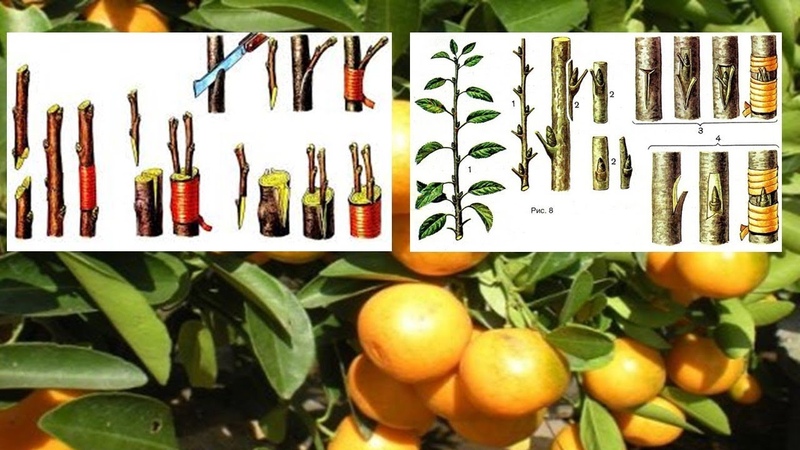
Graft:
- Accelerates the onset of flowering and fruiting. Successfully vaccinated mandarin bears fruit abundantly in 2-3 years after the procedure. In an unvaccinated tree that has grown from a seed, fruits are formed in 7-10 years.
- Provides a high-quality crop in large quantities. The fruits of the scion, in contrast to the bitter ones in the wild, are juicy and sweet in taste.
When to vaccinate
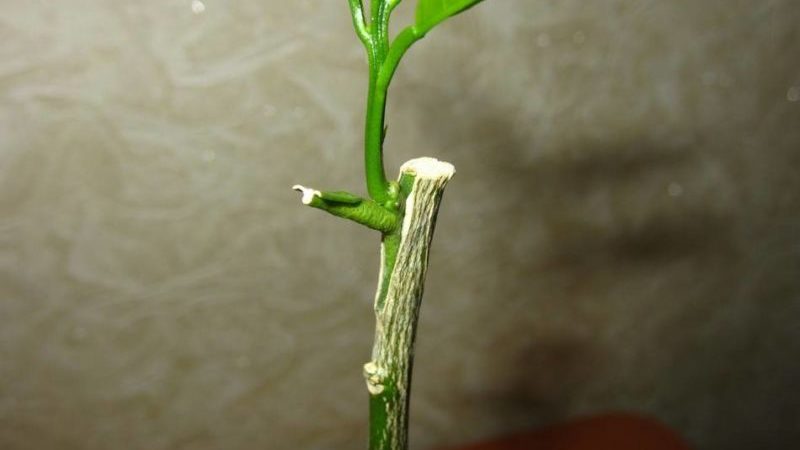
The best time for the procedure is in the spring months. At this time, the tree wakes up, intensive sap flow begins. The bark is easily separated from the wood, which makes the operation easier. From March to May, the plant will safely transfer the vaccination and get stronger after it, the cuts will tighten faster.
Reference! Grafting is possible in August, when the tangerine tree is full of strength.
Autumn and winter are the dormant period of the plant, when it is better not to injure it.
The main methods of vaccination
There are three methods of grafting mandarin at home: for the bark, in the cleft and with eyes. All methods are quite simple, but require knowledge of the technology.
For the bark
How to graft a tangerine tree over the bark:
- A branch is cut off on the rootstock, the bark is cut on it by about 3 cm.
- The edges of the bark are opened and a pointed scion with an oblique cut is placed there so that the surfaces of the plants are connected.
- Up to 3 scions are grafted onto powerful shoots at intervals of up to 4 cm from each other. If vaccinated in a circle, the tangerine tree will have a lush crown.
- The graft is fixed with electrical tape.
- The tree is placed in a greenhouse, periodically ventilated.
Into the cleft
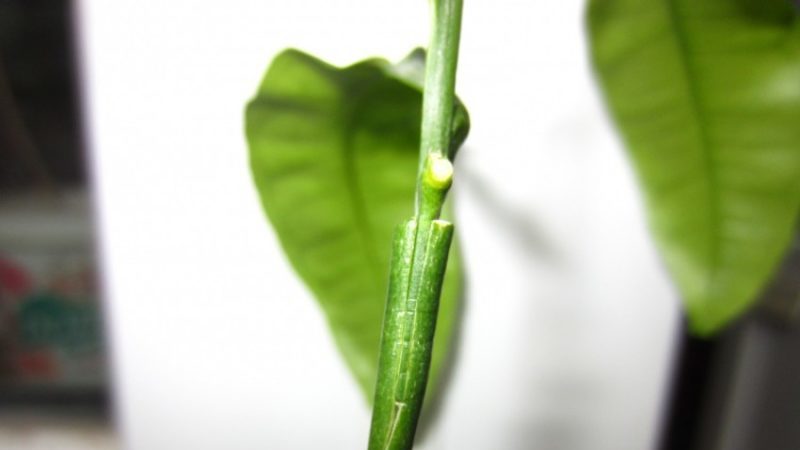
How to pinch a tangerine correctly:
- A branch is cut on the rootstock at a distance of 10 cm above land... The resulting foam is split to a depth of 3-5 cm.
- In the lower part of the scion (branches with buds), a wedge is formed by two cuts at an angle of 3-4 cm long.
- The wedge is inserted into the split so that the slices are tightly connected to each other on one side.
- The grafting site is fastened with electrical tape.
- The tree is placed in a greenhouse from a bag or plastic bottle. To avoid decay, the greenhouse is aired daily.
Budding
Budding, or peephole (single bud) grafting, is considered the most effective and least damaging method. Sequencing:
- The stem of the stock is wiped with a damp cloth to remove dust.
- A peephole is carefully cut from the scion branch - the place of the bark with the bud.
- On the bark of the stock with a sterile instrument, a dissection is made at a distance of 6–10 cm from the ground surface in the shape of a T with a vertical strip of 1 cm and a horizontal strip of 2-3 cm.
- The bark on the tree is folded back with a knife, a peephole is placed inside and pressed down with bark.
- Open areas are treated with garden pitch, rewound with electrical tape so that the kidney is open.
- The tree is placed in a greenhouse for 15 days, which is aired daily.
- After a month, the apical stem of the stock is trimmed by 10 cm.
A sign of a successful vaccination is the yellow color of the eye after 10 days.
Homemade mandarin vaccination rules
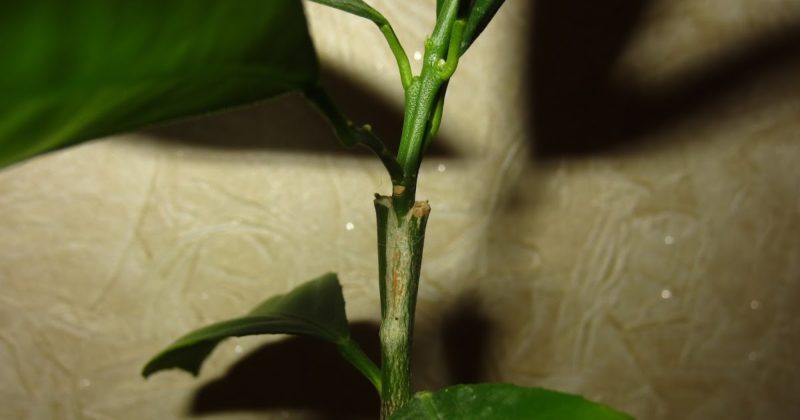
To plant a tangerine at home without mistakes, it is important to adhere to the rules:
- the procedure is performed no more than 1-2 times a year;
- do everything quickly and clearly;
- all cuts and cuts must be smooth and clean, without chipping;
- before the procedure, hands are thoroughly washed, instruments are disinfected;
- the cut is not touched: this will provoke an infection of the stock;
- wounds on the plant are treated with garden varnish to avoid wood oxidation and scion rejection.
Training
To inoculate indoor tangerine you will need:
- sharpened knife;
- insulating tape;
- garden pitch;
- plastic bag or plastic bottle;
- scion - a branch of fruiting citrus;
- stock - a tree grown from a tangerine seed.
A few days before the procedure, the tree is watered abundantly and the bark is checked freely by making a test incision over the site of future grafting.
Reference! Vara recipe: rosin, beeswax and animal fat in a 4: 2: 1 ratio. The ingredients are boiled for half an hour, cooled and ground into a homogeneous mass.
It is better to carry out the procedure on a rainy day or in a room with high humidity: such conditions will not allow the scion to dry out.
Choice of rootstock and scion
The stock - grown wild boar - must be healthy and strong. It is better to plant tangerines older than 2 years: this is how long the plant takes to form a root system and a sufficiently strong trunk 5-7 mm thick.
A sprig of an adult fruiting citrus tree (tangerine, lemon or orange) with 2–4 buds is used as a scion. Related varieties adapt more easily and quickly. The thickness of the scion should be similar in diameter to the stem of the rootstock.
Procedure
How to inoculate tangerine correctly:
- The stock is cut, leaving up to 10 cm above the ground. Before this, the place of the future cut is cleaned of dirt and dust with a rag.
- A scion is prepared: the petiole is cut off, leaving 2-4 mature buds. It is better to remove the leaves. The side of the scion that will touch the rootstock cut off wedge.
- In accordance with the selected method of grafting, either an incision is made in the bark, or the trunk is split.
- The scion is inserted into the incision, tightly connecting the surfaces of the trunk and the cutting.
- Open places are treated with garden pitch. The connection is tied with electrical tape.
- They put the tree in a greenhouse: put a bag or a cut plastic bottle on top.
It is important to combine the cambial layers (a thin ring under the bark) of the rootstock and scion, which are responsible for the growth of shoots in thickness and the formation of blood vessels. As a result, callus is formed around the slices - a tissue that promotes the fusion of grafts.
Further care
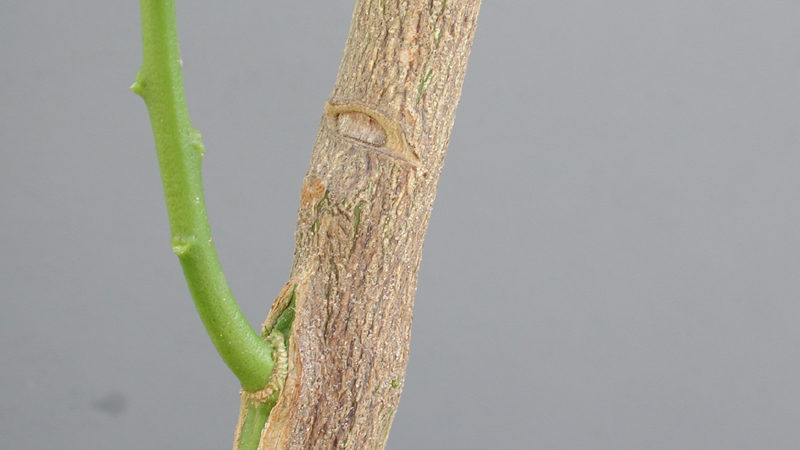
Recommendations for caring for a tangerine tree immediately after grafting:
- for the first month, the plant is kept in a greenhouse from a bag or a cut plastic bottle to create optimal humidity, temperature and protection from drafts;
- to prevent rotting, the tree is ventilated every day, they make sun and air baths;
- the electrical tape is weakened after 2 weeks, after a month it is completely removed;
- after bud germination, the mandarin trunk is shortened by a cut at an angle at a distance of 6–10 cm from the scion.
If successful, after 10–20 days the scion will be green or yellow, and the place of combination will begin to grow together. If the scion has not taken root, it turns black, rots.
Important! Such a tangerine is removed from the greenhouse, bandaged, the scion is removed, and the bark cut is treated with garden pitch.
In order for the tree to grow and bear fruit in the future, it is properly looked after:
- Conditions of detention: uniform lighting, sufficient sunlight, air humidity from 50%, comfortable temperature conditions: in the warm season - up to + 20 ... + 25 ° C, in the cold - within + 5 ... + 10 ° C.
- In the summer, the plant is watered 2-3 times a week, in the winter - 1 time, using settled or filtered water.
- The bush is sprayed from a spray bottle, in the summer - every 2 days, in the winter - once every 2 weeks.
- Special fertilizers for citrus fruits are applied 2-3 times a month during the spring-summer period.
- Mandarins up to 4 years old are transplanted every year, adult plants - every 2 years. Do it in the spring.
- Excess and damaged branches are cut to improve fruiting, the formation of a decorative crown. The trunk is periodically shortened.
- Winter is a dormant period. At this time, the number of watering is reduced and top dressing... The temperature is kept within + 15 ° C.
To prevent diseases, once every 2 months, the culture is watered with a weak solution of potassium permanganate.
It is interesting:
Health benefits and harms of tangerines, energy value and rules of use.
Conclusion
Tangerine grafting guarantees abundant flowering and fruiting. To do this, choose one of three methods: by splitting, by bark or budding. Complete and competent care of the plant ensures successful adaptation of the scion, the formation of common vessels and other tissues.